




How to Use the Pythagorean Theorem in Everyday Situations
The Pythagorean theorem also known as the Pythagoras theorem explains “the relationship between the three sides of a right-angled triangle which are also referred to as the Pythagorean Triplet”.
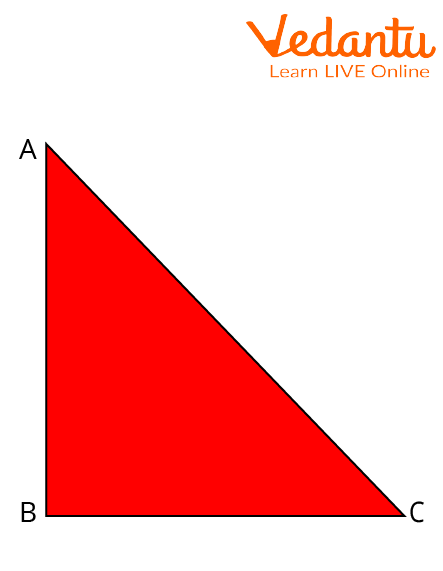
Right-Angled Triangle
In the figure shown above, $ABC$ is a right-angle triangle with right angled at $B$ and $AC$ in the hypotenuse, $BC$ is the base for angle $C$ and $AB$ is perpendicular. $\underline{\underline{\text { So }}}$ in this Triangle according to Pythagoras' Theorem:
$(A C)^{2}=(A B)^{2}+(BC)^{2}$
In this article, we will be discussing the real-life application of the Pythagoras theorem, i.e., the application of the theorem in our daily life.
History of Mathematician
The Pythagorean theorem takes its name from the ancient Greek mathematician Pythagoras.

Scientist Pythagoras
Name: Pythagoras
Born: About 570 BC
Died: About 490 BC
Field: Mathematics and Philosopher
Nationality: Greek
Statement of Pythagoras Theorem
Pythagoras theorem states that “In a right-angled triangle, the square of the hypotenuse side is equal to the sum of squares of the perpendicular and the base, i.e., the other sides of the triangle.”
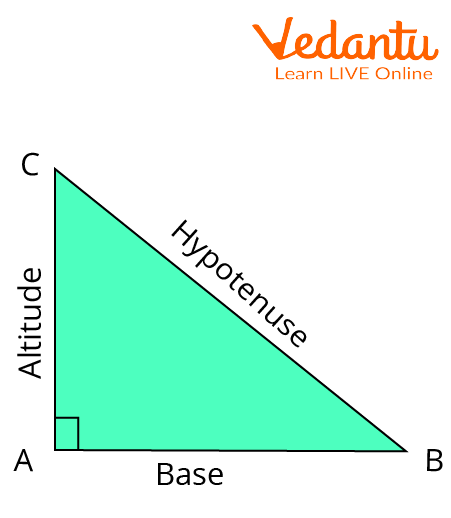
Statement of Pythagoras Theorem
In the above triangle, for angle $B, B C$ is the hypotenuse, $A B$ is the base, and $A C$ is the perpendicular. So,
$(B C)^{2}=(A B)^{2}+(AC)^{2}$
Note: Hypotenuse is the longest side of the right-angle triangle.
The Formula of Pythagoras Theorem
$(\text { Hypotenuse })^{2}=(\text { Base })^{2}+(\text { Perpendicular })^{2} \\$
$(B C)^{2}=(A B)^{2}+(AC)^{2}$
where BC is hypotenuse, AB is base, and AC is perpendicular for right-angled triangle ABC.
Proof of Pythagoras Theorem
Given: A right-angled triangle $\mathrm{ABC}$, right-angled at $\mathrm{B}$.
To Prove: $A C^{2}=A B^{2}+B C^{2}$
Construction: Draw a perpendicular BD meeting $A C$ at $D$.
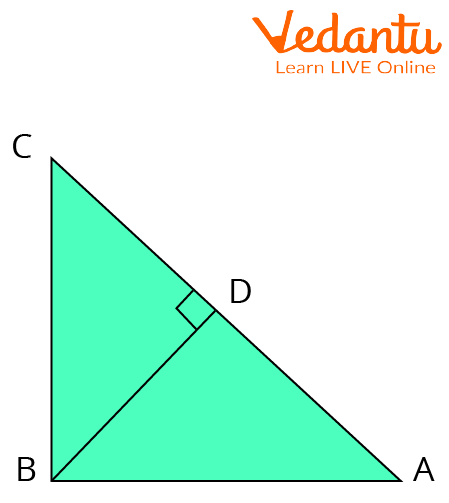
Construction to Prove Pythagoras Theorem
We know $\triangle A D B \sim \triangle A B C$
Therefore,
$\dfrac{A D}{A B}=\dfrac{A B}{A C}$
(Corresponding sides of similar triangles)
Or, $A B^{2}=A D \times A C$
Also, $\triangle B D C \sim \triangle A B C$
Therefore,
$\dfrac{C D}{B C}=\dfrac{B C}{A C}$
(Corresponding sides of similar triangles)
or, $B C^{2}=C D \times A C$
Adding the equations (1) and (2), we get,
$A B^{2}+B C^{2}=A D \times A C+C D \times A C$
$\Rightarrow A B^{2}+B C^{2}=A C(A D+C D)$
Since $A D+C D=A C$
Therefore, $A C^{2}=A B^{2}+B C^{2}$
Hence, we proved Pythagoras theorem.
Now, Let us discuss the converse of Pythagoras Theorem with detailed proof.
Converse of Pythagoras Theorem and Its Proof
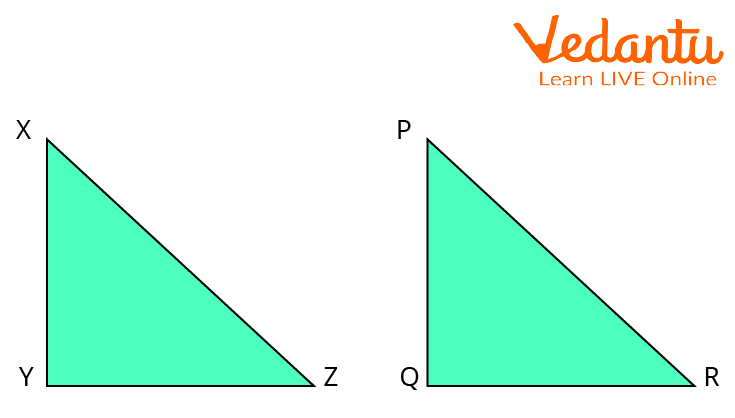
Two Right-Angled Similar Triangles
In a triangle, if the square of one side is equal to the sum of the other two sides, then the angle opposite the first side is a right angle.
Given: $\ln \Delta X Y Z, X Y^{2}+Y Z^{2}=X Z^{2}$
To prove: $\angle X Y Z=90^{\circ}$
Construction: A triangle PQR is constructed such that a triangle $P Q R$ is constructed such that
$P Q=X Y, Q R=Y Z \angle P Q R=90^{\circ}$
Proof: $\ln \triangle P Q R, \angle Q=90^{\circ}$
$P R^{2}=P Q^{2}+Q R^{2}$ {Pythagoras theorem}
or $P R^{2}=X Y^{2}+Y Z^{2} \ldots$ (i) $[P Q=X Y, Q R=Y Z]$
But we know $X Z^{2}=X Y^{2}+Y Z^{2} \ldots \ldots$ (ii) (given)
Therefore, $X Z^{2}=P R^{2}$ {From equation (i) and (ii)}
or $X Z=P R$
or $\triangle X Y Z \cong \triangle P Q R$ {SSS congruence rule}
Therefore, $\angle Y=\angle Q=90^{\circ}$ {CPCT}
Hence, $\angle X Y Z=90^{\circ}$
The converse of Pythagoras theorem is proved.
Application of Pythagoras Theorem
Pythagoras Theorem is used to find the steepness of hills.
In Artificial intelligence: face recognition features in security cameras use the Pythagorean theorem. The distance between the camera and the person is recorded.
Pythagoras Theorem is used to find the shortest distance in Navigation.
The concept of the Pythagoras Theorem is also used in Interior Designing.
Pythagoras theorem is used to find the third side of a right-angled triangle when 2 sides are given.
In Engineering, the diameter can be easily calculated when length and breadth are known using Pythagoras Theorem.
Limitations
Pythagoras Theorem is only applicable in the case of the Right-Angled Triangle. If one of the angles is not 90 degrees, then we cannot use Pythagoras Theorem.
Pythagoras Theorem is only useful in the case of 2-dimensional figures. It cannot be applied in the case of 3-dimensional figures or objects.
Solved Examples
1. The perpendicular of a right-angled triangle is given as 12cm and the hypotenuse is given as 13cm. Find the base of the given triangle.
Solution:
Perpendicular $=12 \mathrm{~cm}$
Base $=b \mathrm{~cm}$
Hypotenuse $=13 \mathrm{~cm}$
As per the Pythagorean Theorem, we have
$Perpendicular^{2}+ Base^{2}= Hypotenuse^{2}$
$\Rightarrow 12^{2}+b^{2}=13^{2}$
$\Rightarrow 144+b^{2}=169$
$\Rightarrow b^{2}=169-144$
$\Rightarrow b^{2}=25$
$\Rightarrow b=\sqrt{25}$
Therefore, $b=5 \mathrm{~cm}$
2. The sides of a triangle are 15, 17, and 8 units. Check if it has a right angle or not.
Solution: Clearly, 17 is the longest side.
It also satisfies the condition $15+8>17$
We know
$c^{2}=a^{2}+b^{2}$
So, let $a=15, b=8$, and $c=17$
First, we will solve R.H.S. of Equation (1).
$a^{2}+b^{2}=15^{2}+8^{2}=225+64=289$
Now, taking L.H.S, we get
$c^{2}=17^{2}=289$
We can see LHS=RHS.
Therefore, the given triangle is a right triangle, as it satisfies the Pythagoras theorem.
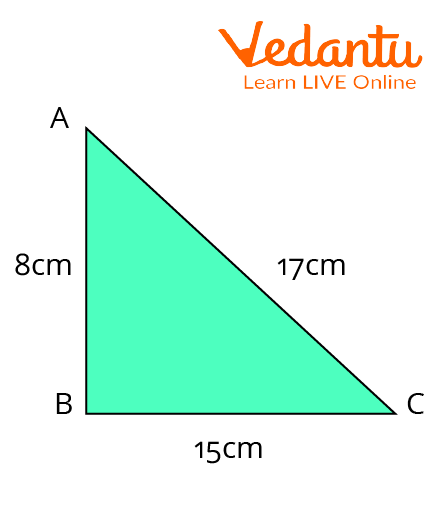
To Check Angle of Triangle
Important Formulas
For any Right-Angled Triangle,
$(\text { Hypotenuse })^{2}=(\text { Base })^{2}+(\text { Perpendicular })^{2}$
Important Points to Remember
Pythagoras theorem is applicable only in case of a right-angled triangle.
Trigonometry is based on the Pythagoras Theorem.
Conclusion
In this article, we discussed the Pythagoras Theorem in depth. The proof, statement, applications, and examples are thoroughly explained above. From the discussion above about the Pythagoras theorem, we can conclude that it is a very useful theorem to be used in solving questions of a right-angle triangle and it helps us in real life a lot.
FAQs on Real-Life Applications of Pythagorean Theorem
1. What is the fundamental principle behind using the Pythagorean theorem in real life?
The fundamental principle is using the relationship in a right-angled triangle to calculate an unknown distance indirectly. If you can imagine a situation as a right-angled triangle, and you know the lengths of two sides, you can always find the length of the third. The theorem, a² + b² = c², provides a precise mathematical tool for finding this missing length, which is crucial in scenarios where direct measurement is difficult or impossible.
2. What are some common examples of the Pythagorean theorem's application in daily life?
The Pythagorean theorem is used in many real-world situations to ensure accuracy and solve for unknown distances. Some key examples include:
- Architecture and Construction: To ensure that corners of buildings are perfectly square (90 degrees) and for calculating the required length of support beams or rafters.
- Navigation: To find the shortest distance between two points. A boat's path might involve moving north and then west, but the theorem can calculate its direct distance from the starting point.
- Surveying: Land surveyors use it to calculate the steepness of slopes and to map out areas by creating right-angled triangles between points.
- Design: In graphic design or video games, it is used to calculate distances between objects on a 2D screen (using x and y coordinates).
3. How can you use the Pythagorean theorem to find a missing distance, for example, with a ladder against a wall?
Imagine a ladder leaning against a wall. The ladder itself forms the hypotenuse (c), the wall forms a vertical side (a), and the ground forms the horizontal side (b), creating a right-angled triangle. If you know the height the ladder reaches on the wall (a = 8 feet) and how far the base of the ladder is from the wall (b = 6 feet), you can calculate the ladder's length (c) as follows:
1. Use the formula: a² + b² = c²
2. Substitute the known values: 8² + 6² = c²
3. Calculate the squares: 64 + 36 = c²
4. Sum them up: 100 = c²
5. Find the square root: c = √100 = 10 feet. The ladder must be 10 feet long.
4. Why is the Pythagorean theorem only applicable to right-angled triangles and not others?
The Pythagorean theorem is a special property that exclusively applies to right-angled triangles because its formula, a² + b² = c², is directly tied to the geometric properties of a 90-degree angle. In a right-angled triangle, the square of the hypotenuse is exactly equal to the sum of the squares of the other two sides. For other triangles:
- In an acute triangle (all angles less than 90°), a² + b² > c².
- In an obtuse triangle (one angle greater than 90°), a² + b² < c².
Therefore, the equality only holds true where the angle between sides 'a' and 'b' is exactly 90 degrees.
5. What is the importance of knowing Pythagorean triples like (3, 4, 5) in real-life applications?
Knowing Pythagorean triples is important because they act as a mental shortcut for creating perfect right angles without needing a calculator. For instance, in construction or carpentry, a builder can measure 3 units along one edge and 4 units along an adjacent edge. If the distance between those two endpoints is exactly 5 units, they know the corner is a perfect 90-degree angle. This technique, often called the '3-4-5 rule', is a quick and reliable way to ensure structural accuracy on-site.
6. What is the most common mistake students make when applying the Pythagorean theorem to real-world problems?
The most common mistake is incorrectly identifying the hypotenuse. In a word problem or a real-world scenario, students might mix up which side is 'a', 'b', or 'c'. It is crucial to remember that the hypotenuse ('c') is always the longest side and is always opposite the right angle. Failing to assign the longest side as the hypotenuse in the formula a² + b² = c² will lead to an incorrect answer.
7. How does the Pythagorean theorem form the basis for other concepts in maths, like trigonometry?
The Pythagorean theorem is foundational to trigonometry. In a right-angled triangle placed on a coordinate plane (the unit circle), the theorem relates the x-coordinate, y-coordinate, and the radius. This relationship directly gives rise to the most fundamental Pythagorean identity in trigonometry: sin²(θ) + cos²(θ) = 1. This identity is derived from a² + b² = c² and is essential for solving complex trigonometric equations and proofs.




























